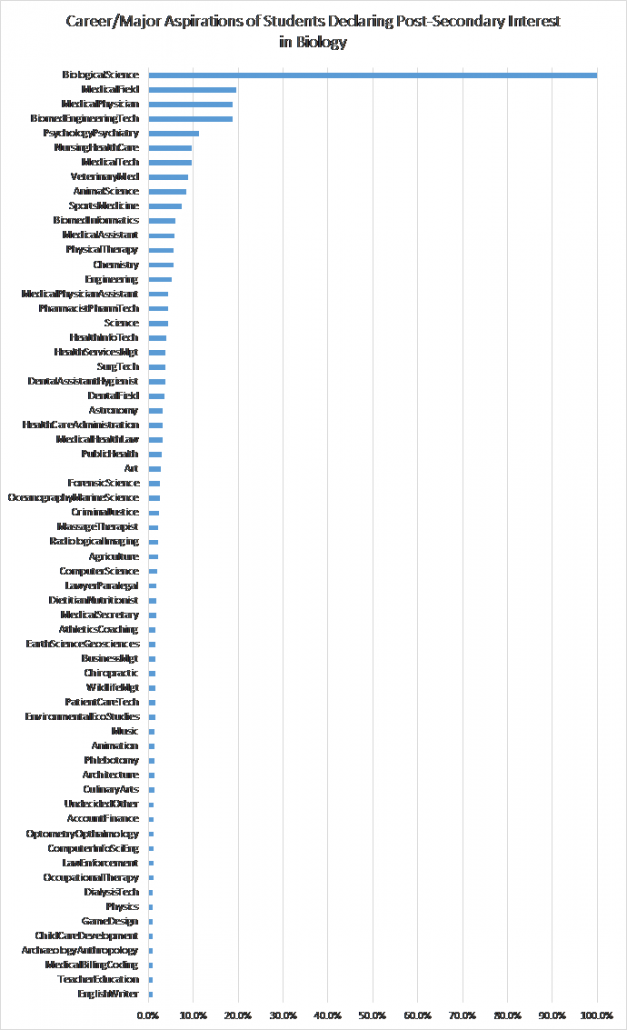 During the 2015-2016 school year, 6513 students[1] responding to our combined Research Consortium surveys expressed interest in Biology as a career or major. [2]
During the 2015-2016 school year, 6513 students[1] responding to our combined Research Consortium surveys expressed interest in Biology as a career or major. [2]
These students are somewhat more likely to be female than male (58% vs. 42%). Females are more likely than males to identify biology as a career/subject area of interest (3.6% vs. 3.1%).
Racial differences in interest in biology emerge as well. Among those considering a biology major or career:
- Fifty-two percent are white, 24% are Hispanic, 17% are Black, 10% are Asian, and 8% are American Indian.
- Asians are most likely to choose biology as a major/ career pathway (5.6%) and Blacks are least likely to do so (2.6%).
- The observed racial/ethnic patterns of interest hold, regardless of gender.
Post-secondary Education Plans
Biology aspirants differ in important ways from other students. Biology aspirants are:
- More likely than non-aspirants to hope to attend a state university (84% vs. 76%) or private university (39% vs. 24%).
- Less likely to aspire to attend community colleges (16% vs. 23%), online colleges (5% vs. 3%), or a career/ technical school (8% vs. 13%).
Gender differences. Noteworthy gender differences emerge in the educational plans of students aspiring to biology careers. Among those who may pursue biology after high school, females more often than males consider attending:
- state universities (88% vs 81%),
- private colleges (42% vs. 34%),
- community colleges (25% vs 16%).
High School Experience
Students aspiring to major in biology or pursue careers in biology are more likely than students not aspiring to pursue biology to take college-credit (31% vs. 20%), AP (41% vs. 21%), and honors classes (48% vs. 30%).
Those interested in biology are equally or less likely to report completing International Baccalaureate, AVID, General College Prep, Career Technical Education, or “Other” special classes.
Biology majors/careers are roughly twice as likely to be an aspiration for A students (4.8%) as for B students (2.7%) or C students (1.87%).
Gender differences: Among biology aspirants, females are more likely than males to report taking AP classes (46% vs. 36%), honors classes (52% vs. 45%), and college credit courses (33% vs. 29%).
Graduating Class
Biology aspirations remain relatively stable across graduating classes, with 3.33% aspiring in the freshman cohort and 3.45% in the senior class cohort.
However, a slight (and not statistically significant) trend may deserve further exploration. The proportion of male and female students aspiring to biology is equal within the freshman cohort, but inches upward among females as they approach graduation[3] and downward among males as they approach graduation.
Career Pathway Influences:
The top five influences cited by students aspiring to biology careers/degrees are:
- own interests/ experiences (72%)
- mothers (23%)
- fathers (17%)
- classes (17%)
- teachers (12%)
Parents are slightly less influential among biology aspirants than they are among non-aspirants. Schools – teachers and classes – are slightly more important influences for aspiring biologists than they are among biology non-aspirants.
Social media is among the least cited career influences for biology aspirants (4%) and guidance counselors are the least influential for biology aspirants (2%).
Gender differences. Among biology aspirants, some gender differences in career influences appear.
- More females than males cite own interests/ experiences as an influence (75% vs. 69%)
- More males than females cite fathers as an influence (22% vs. 13%)
- More females than males cite mothers as an influence (26% vs. 19%).
- More females than males cite classes as an influence (17% vs. 8%).
Females aspiring to biology majors/careers are slightly more likely than males to cite “other family” as an influence (5% vs. 2%).
These patterns suggest curriculum-based approaches and family guidance may be good ways to interest more females in pursuing biology. The gender gap in proportion citing classes as an influence suggests educators might explore ways to make classroom learning more appealing to males.
Career Pathways: Alternatives and Specialization
Students surveyed could choose more than one career/major. Some may have chosen another option that would allow them to apply their biology training (e.g., education or medical career). Others may have selected options that would generally require students to move away from biology. Virtually all students (98%) who expressed an interest in biology as a major or career also select one or more addition majors/careers they were considering.
The table that follows shows the career/major aspirations of those who selected biology as one of their possible career pathways. Only majors/careers of interest to 1% or more of those with interest in biology are shown.

Implications
Virtually all high school students who select biology as a possible major or career are considering other careers/ majors. The top twelve occupations/majors selected in addition to biology focus on health careers.[4]
The data suggest ideas for increasing the number of students who consider biology as a major/career path. These include:
- Increasing outreach to underrepresented groups, particularly African-Americans, Hispanics, and Native Americans who are about half as likely as Asian students to express interest in biology.
- Connecting biology more explicitly to popular career pathways like health careers. Indeed, only about 8% considering health careers express an interest in biology.
- Increasing opportunities for students interested in biology to learn how community colleges may help them achieve their educational goals – since biology aspirants express interest in community colleges less often than other students do.
- Encouraging males to better prepare for post-secondary career pathways that involve biology – whether it is post-secondary education that females are more likely to plan to pursue or challenging high school coursework (AP, honors, college credit) that will prepare them for success.
- Reaching out to parents who are among the most frequently cited influences on career choice – but less frequently cited by those who are considering pursuing biology.
- Reinforcing and supporting educators. Classes are as important as fathers are as influences for those considering biology careers/majors. Classes are twice as important for aspirants as non-aspirants.
- Explore ways to reach students through social media. These digital natives who are considering biology rate social media near the bottom as an influence on career choice.
- Explore the potential strategies that could make the high school experience more effective in attracting students to biology.
[1] Biology was not an option on the CTE survey. The closest choices to biology on that survey were Biomedical Engineering Tech and Biomedical Informatics. Students choosing one of these three options total 8797. This adds 1012 respondents from the CTE sample, with the remaining 1272 coming from surveys that had also included Biology as an option. This memo focuses on the 6513 who expressed an interest in a biology career/major.
[2] The Educational Research Center of American (ERCA) managed surveys of national samples of students during the 2015-16 academic year for several Research Consortia. The survey was conducted in-class with paper surveys. The students represent a cross-section of college bound and non-college bound students. The margin of error for the combined surveys is +/- 1% at the 95% confidence interval. ERCA appreciates the support of its partners involved in these consortia: SkillsUSA, National Girls Collaborative Project, Manufacturing Institute, National Association of Biology Teachers, National Alliance for Partnerships in Equity, and Destination Imagination.
[3] Differences are small, with 3.4% of male and female freshmen aspiring to biology. Among females the proportion inches upward to 4% among seniors, and inches downward to 2.9% among males in the senior cohort.
[4] However, health career aspirants are only a minority of those who express interest in biology. Among the entire sample of students, one striking pattern is that only 7.5% of all students who are considering health careers express an interest in biology. The 92.5% considering only health careers (but who do not consider biology as a major/career path) may be a yet-to-be-fully-cultivated pool of future students for biology educators.

